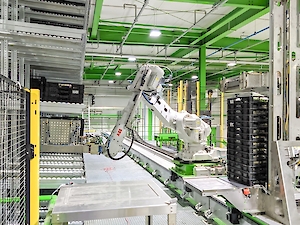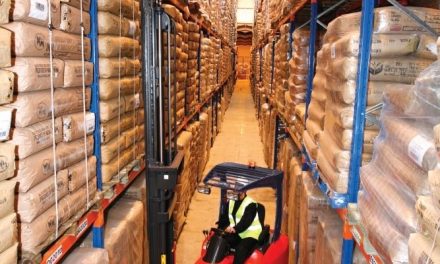Robot-led automation can make a tremendous difference to the efficiency, accuracy and flexibility of logistics operations in the retail warehouse, says Nigel Platt.
 Meeting the expectations of fast delivery of anything one can think of needs a logistics operation to match. For busy warehouses and distribution centres, robotic automation has been shown to deliver a demonstrable return on investment through increased efficiency, higher throughput combined with improved accuracy – and hence, fewer returns and improved customer satisfaction. It also offers flexibility as a way of future-proofing logistics operations against changes, not only in the level of demand but also in the form it takes and the channels it uses.
Meeting the expectations of fast delivery of anything one can think of needs a logistics operation to match. For busy warehouses and distribution centres, robotic automation has been shown to deliver a demonstrable return on investment through increased efficiency, higher throughput combined with improved accuracy – and hence, fewer returns and improved customer satisfaction. It also offers flexibility as a way of future-proofing logistics operations against changes, not only in the level of demand but also in the form it takes and the channels it uses.
To take one example, in the UK’s coronavirus lockdown from the end of March onwards, food industry producers in areas as diverse as meat & poultry and heritage potatoes, previously supplying the restaurant and catering sector, had to shift focus quickly. Many attempted to pivot towards supplying bricks-and-mortar retail or, if they were fortunate, home-delivery channels.
For retail, this may partly be to do with adapting primary processing and packing, but it was also – crucially – about having outbound logistics which could divert product from smaller batches and deliveries for individual foodservice outlets to larger shipments to retailer distribution centres.
Likewise, the crisis has highlighted the benefits of flexible automation within retailer logistics. Taking some of the pressure off individual stores which are left to manage stock destined for home delivery, Aldi in April launched a ‘food parcel’ system of essential groceries delivered directly from the chain’s warehouse. This must have constituted a major logistical challenge.
During the lockdown, large-scale readjustment has also been necessary in the e-commerce and parcels sectors. Overall, GlobalData forecasts a 20 per cent growth in the UK’s online food and grocery market during 2020. The bottleneck for many will be the numbers of vehicles available and deliveries that can be made. But faster order-picking and despatch is also a requirement.
 The search for flexibility
The search for flexibility
The logic of ducking capital expenditure in favour of a ‘flexible’ temporary labour force has been unravelling over recent years, with the availability of a ready supply of labour steadily dwindling. Add to this the heightened risk when it comes to worker safety and human error with regards to order fulfilment, and the benefits of increasing the deployment of automation to handle logistics tasks quite literally starts to stack up.
As with other industrial sectors in the UK, the logistics sector has been cautious about switching to unfamiliar technologies, with operators eager to see working examples of systems performing the same or similar functions. However, while fully automated warehouses and distribution centres still tend to remain the exception rather than the rule, there has been a growing interest in deploying robot automation to handle a growing range of tasks as users have become more aware of the potential benefits it can offer.
Part of this is down to the way that robot systems have evolved to offer more sector- and function-specific hardware and software options, with less need for the costly and time-consuming customisation of generic models. Lead-times and commissioning times can often be further shortened by the use of digital-twin simulation for a virtual check of online-specific operation and compatibility. Integrated and modular systems are more readily available.
The ‘black box’ image that used to hinder robotics is also largely a thing of the past, too, thanks to more accessible programming options and security features. Together with the ability to quickly and easily switchover between robot programs to handle different goods, advances in robot technology and interfaces have granted users a greater sense of ‘ownership’, with the ability to carry out many programming and simple house-keeping tasks without so much reliance on outside engineers. It is also true, however, that those who have invested in robotic automation have been reassured by the level of continued support they have seen from providers, whether for maintenance, troubleshooting, upgrades, or where necessary, reprogramming.
Quite rightly, the publicity generated by collaborative robots (cobots) has helped to ease any concerns potential users may have felt about safety. But it is also true that robot safety across the broader range of systems has not only improved but become more transparent to end-users. A great deal of thought – and programming – has been put into how humans and robots can work confidently side-by-side in busy environments.
Four ways that robots are transforming logistics operations
Whether as part of an FMCG end-of-line operation, retail distribution centre, e-commerce fulfilment site or parcels-sorting facility, robotic automation offers a wide range of functions. Four key areas of product handling and sorting across these and other logistics roles are as follows:
• Item picking. Equipped with high-speed vision systems to identify product codes or other data, robotic item picking is reliable, efficient and – depending on the specified payload – compatible with items across a range of weights.
• Palletising, depalletising, repalletising. Whether for cases or (more often as retailers and other businesses increasingly opt for returnable systems) for tote bins, palletising and depalletising are well-established robotic options. At a manufacturer’s end-of-line, in distribution centres and many locations besides, robotic systems offer fast and efficient palletising with precise placement according to programmed pallet patterns. As well as providing reliable and secure pallet-building, they avoid potential operator issues with manual handling of loads.
• Robotic storage and retrieval systems. Invaluable in an e-commerce setting where multi-product, consolidated orders need to be accurately accumulated for dispatch, a robotic storage and retrieval system uses encoded data to identify, temporarily store and match items. Again, repeat reliability is a key benefit.
• Singulation and sortation. In a parcel-sorting operation, a robot arm can be used in combination with vision systems to automatically singulate packages, assess their size and redirect them for induction into the correct downstream sorting zone.
In all these roles, robotics can make inefficient, imprecise and potentially unsafe manual routines efficient, reliably precise and much safer. They offer no limits on the number of shifts that can be worked.
But robotics does not only help to augment the performance of human operators. In many settings, one option remains the use of traditional automatic palletising rather than a robotic arm system. The problem is that conventional palletising is often tailored for a specific size of pallet and unit, with none of the adaptability of a robot. At the same time, the continual evolution and optimisation of end-of-arm tooling means that, even when there is a radical change in packaging, tooling can be supplied to reliably lift and place each unit in whatever pattern is required.
In e-commerce, the gap between the speed and efficiency of intelligent automated systems and human operators is especially noticeable when components of a single order are kept in temporary storage and then consolidated when complete. In this area, there is also a growing installed base of integrated systems, where buffering and order consolidation are combined with palletising, or with alternative automated systems readying consignments for distribution.
In parcels handling, the singulation process, which is still commonly performed manually, once automated, allows items to be pulled out of a fast-moving stream on the basis of size or other criteria. This is one of those areas where the existence of robot cells designed for this specific role can help to shorten order lead-times, installation and commissioning.
Delivering the flexibility for the future
We can conclude that, for many in logistics, the coronavirus lockdown and its consequences have served to underscore the importance of systems which are not only flexible, but flexible in ways that might never have been envisaged in the past. Building in this ‘what if…?’ element need not add hugely to the capital cost of a project, while conferring considerable competitive advantage in the event of these additional options coming into their own.
But of course, many of the benefits of flexibility in more ‘normal’ times are to do with evolution rather than revolution. They are not about a sudden shift from one sales channel to another, but having the capacity for a gradual drift, for example, towards e-commerce and home delivery, while keeping all retail options open. It might also be about an ability to handle seasonal fluctuations in parcel volumes or a trend towards larger unit sizes.
In suggesting an equipment specification, an experienced partner in logistics automation will always bear in mind these and many other possibilities for tomorrow – but without losing sight of today’s necessities.
Nigel Platt, ABB Robotics
For more information, visit https://bit.ly/2R57AdH





